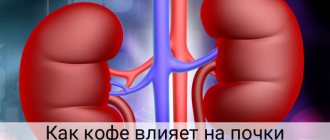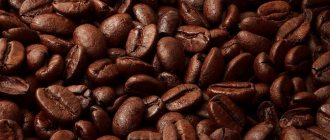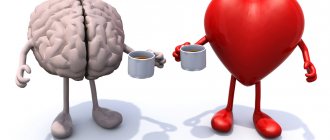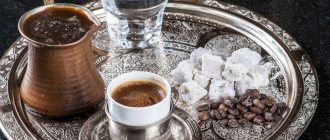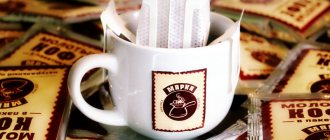Remarkably, decaffeinated coffee was discovered as a result of a coincidence. At the beginning of the 20th century, a German entrepreneur was transporting coffee beans for sale, but was caught in a severe storm along the way. The bags of goods became very wet, and the grains were saturated with salty sea water.
After arriving at the place, the merchant planned to get rid of the goods, realizing that they were hopelessly damaged. However, German frugality prevailed over common sense and the entrepreneur decided to try to return the grains to marketable condition. The coffee was thoroughly washed, dried and roasted. The drink obtained from these grains came out aromatic and tasty, but with one drawback - it no longer invigorated or toned. So, quite by accident, a new type of coffee was invented - decaffeinated.
- Features of the technology for producing caffeine-free beans
- Natural caffeine-free beans - do they exist?
- Popular brands of decaffeinated coffee
- About the dangers of caffeine-free pleasure
- About the benefits of decaffeinated coffee
- Non-alkaloid drink for nursing - is it possible or not?
How to make decaffeinated coffee
Decaffeination is the name given to the process of extracting caffeine from coffee beans. This procedure can be carried out in several ways, each of which has certain advantages and disadvantages.
Swiss method
They began producing decaffeinated coffee in this way back in the late seventies of the last century and it is still considered one of the most effective. Thanks to its use, it is possible to achieve the lowest possible caffeine content (0.01%).
The method involves performing the following actions:
- The fruits of the coffee tree are poured with water and left to settle. Due to this, aromatic oils and alkaloids pass into liquid.
- The water is passed through filters in which the natural stimulant remains.
- The purified flavored liquid is returned to the beans.
- The whole process is repeated one more time.
The only drawback of the Swiss method is its high cost. This inevitably affects the cost of the finished product
Direct method
This technology is often called traditional, as well as European. It involves performing the following actions:
- The beans are immersed in hot water and, after soaking, transferred to a solvent. In this way, the alkaloid is extracted from them.
- Then the grains are rinsed in boiling water.
- At the last stage they are dried.
The disadvantage of this method is the use of a solvent. As a result of its use, chemical compounds inevitably remain in the finished product.
Indirect method
The technology is in many ways similar to the direct method, but has certain features. Here, too, the beans are soaked and then processed with a solvent, but the taste and aromatic properties of the product are preserved. Such actions are performed repeatedly.
The method allows you to extract a natural stimulant, but beneficial oils and vitamins remain in the grains. The method is more expensive than the direct method, but the resulting products are of high quality.
CO2 extraction
When using this technology, carbon dioxide is used. In this case, the beans are initially treated with steam, and then placed under pressure in a chamber with CO2. In this case, only caffeine is extracted from the gas. The oils remain in the beans, which preserves the characteristic coffee taste and aroma. There are no foreign impurities in the finished product.
Differences in taste
High-quality decaffeinated coffee has a milder taste and is not as strong as a traditional drink. But taste differences are still present, because at the production stage some of the valuable substances and oils can be extracted along with caffeine. The richness and depth of the flavor palette is partially lost, although with high-quality decaffeination methods these changes are almost unnoticeable.
The cheap traditional method using a solvent has a greater effect on the flavor profile of the drink, plus the chemical can leave its mark if the beans are not washed properly. Therefore, to get a good tasty drink, you should not skimp on its price.
The benefits and harms of the drink
The decaffeinated product also contains a natural stimulant, but its concentration becomes significantly less. Ten servings of this drink will contain the same amount of alkaloid as two cups of regular espresso. Accordingly, it can cause harm. Therefore, consumption of decaffeinated coffee should be limited. You should not drink it in excessively large quantities.
Among the harmful properties of this product are the following:
- increased blood cholesterol levels;
- damage to the walls of blood vessels;
- increased risk of developing arteriosclerosis.
Due to the low concentration of the alkaloid, the drink has a positive effect on the body . Its benefits are as follows:
- acceleration of metabolic processes;
- decreased blood pressure;
- mild effect on the central nervous system;
- stimulation of brain function;
- reducing the risk of cancer and diabetes;
- protecting the liver from toxic effects.
Due to the comparative safety of this drink, its use is allowed even during pregnancy. The main thing is to drink it in moderation, limiting yourself to only 1-2 cups per day.
Benefits of decaf coffee beans
If you choose grains, you can already be sure that the drink will be good and healthy. For this type of coffee, only the best beans are selected, which undergo additional control after roasting. Many useful microelements and substances are better preserved if you grind the beans immediately before cooking. But there are other clear advantages:
- Helps reduce the risk of developing diabetes;
- Protects the liver;
- Improves the activity of the cardiovascular system;
- May enhance brain activity;
- Removes less calcium from the body.
In general, decaffeinated beans contain the same amounts of magnesium and other vitamins as unprocessed beans. But the antioxidant content can be reduced by 15-20%, depending on the processing method.
Brands and types of decaffeinated coffee
This type of coffee is gaining immense popularity. Therefore, all manufacturers are striving to produce decaffeinated products. To choose the best option, you should study the entire range on the market.
In beans
When choosing decaffeinated coffee beans, attention should be paid to the Colombian Arabica brand . This manufacturer uses beans that are initially low in natural alkaloids. After processing, it is possible to obtain a high-quality product. The drink based on it is aromatic, with a rich taste.
Ground coffee
There are varieties of decaffeinated coffee. Such trees grow on Brazilian plantations. The drink prepared on their basis is called Coffeaarabica. The cost of such a product is quite high, so, as a rule, you have to choose ground beans that have gone through the decaffeination process. Among the best brands are the following:
- Green Mountain;
- Cafe Altura;
- Lavazza Decafenato.
These brands of ground beans are suitable for the coffee machine. They can also be used when brewing a drink in any convenient way.
Decaffeinated instant coffee
Among the manufacturers of instant products, the most popular brands should be highlighted:
- Ambassador;
- Nescafe (Finland);
- Jacobs.
It is worth noting that this type of coffee is the least healthy. It contains many chemicals that can have a negative effect on the body.
Famous brands
Natural bean or ground coffee of high quality is made only from Arabica beans. Arabica varieties contain less caffeine than Robusta or Liberica varieties. The best producers of this drink are considered to be Colombian, German and Swiss factories, as well as some American ones. The photo below shows the most popular product in Russia from the Decaf series.
One of the leaders in the CIS market
The most popular brands of decaffeinated coffee are listed below:
- Lavazza Dek Decaffeinato (Lavazza);
- Green Mountain Coffee;
- Cafe Altura;
- Montana Coffee;
- Jacobs Monarch;
- Nescafe Gold Decaf.
Decafei decaffeinated coffee can be purchased in beans, ground and instant. It is also packaged in capsules for special coffee machines. This product is popular in Starbucks and many other coffee chains.
How to make decaffeinated coffee
There are many recipes for making coffee drinks, but in any case the procedure is the same. Regardless of the option chosen, you should follow a number of simple rules.
Water requirements
To prepare a decaffeinated drink, it is extremely important to choose the right water. It must meet the following requirements:
- absence of all kinds of impurities;
- transparent, colorless;
- Odor is unacceptable.
It is recommended to give preference to filtered, bottled or spring water
Cooking rules
The technology for brewing beans is quite simple. It involves performing the following actions:
- Bring 180 ml of water to a boil, and then cool the liquid slightly. The temperature should be between 90-95 degrees.
- Place 10 g of chopped beans in a cup.
- Fill them with hot water.
- The drink is infused for five minutes. After this time, he is ready. You can enjoy its taste and aroma.
Usage rates per day
The opinion that such a drink can be drunk without restrictions is erroneous. Decaf can be consumed in exactly the same quantity as regular natural coffee. You are allowed to drink within 2-4 servings per day . In this case, health status and age are taken into account.
The presence of such a restriction is due to the fact that beans, in addition to the alkaloid, contain a number of other substances, an overdose of which will cause harm to the body.
Caffeine can give you energy and eliminate drowsiness, but not everyone can use it. Therefore, the decaffeinated product is gaining immense popularity. It is produced by various manufacturers. Therefore, everyone can choose the most suitable option for themselves.
Reviews
Inna A .: “What is the name of my favorite decaffeinated coffee? Carte Noire. I haven’t cheated on him for five years. True, I recently came across an obvious fake in one of the online stores: the taste of chicory, burnt particles... It's a shame! But I still won’t give up this coffee, I’ll only now buy not the large packaging, but the small one - if something happens, I’ll be too sorry to throw it away. And what a latte this coffee makes! I drink it in the morning and have enough energy until the evening.”
Daria B .: “While I was expecting the baby, I decided for myself that I wouldn’t drink coffee now. But without coffee I began to feel unwell, it seemed like my heart even began to tingle or I was imagining all this... In order not to suffer, I bought my favorite Nescafe, but without caffeine. Life has become easier again."
Alexey R .: “I somehow didn’t even notice that there was something wrong with the coffee when they poured me a cup of decaffeinated coffee for the first time. Looks like a regular Arabica. But I can afford such coffee not only in the morning, but also in the evening, even when I spend a long time at the computer.”
Which is better: instant or ground coffee, decaffeinated coffee?
It is impossible to answer this question unambiguously. Each product has a number of positive properties and disadvantages. An instant drink has the following advantages:
- It can be stored for a long time.
- It's cheap.
- Prepares quickly.
- It has various additives that give it a good aroma.
Benefits of ground coffee:
- Differs in vitamin content.
- Invigorates the body.
- It has a pleasant taste and aroma.
Ground drinks are made from higher quality raw materials. The result is the product’s ability to energize a person and keep the body in good shape. Instant drinks do not have a similar effect. Another distinctive feature is the concentration of taste. Ground coffee is richer and stronger.
Conclusions:
- Ground coffee, which does not contain caffeine, is much healthier than instant options.
- Decaffeination is usually done by dissolving, steeping, gassing, or straining through a carbon filter.
- The price varies depending on the cleansing technology and brand, and can range from 240 to 1800 rubles, so you will find an option that suits your budget.
- Good decaf tastes just as good as natural decaf.
- Don't drink too much decaf - 5-7 cups can contain as much stimulant as one cup of raw decaf.
How much can you consume without harm to health?
In order not to harm your health, you need to remember the dosages established for use. It is recommended to drink no more than 3 cups of the drink per day (with a mug volume of 150 ml). It is also worth taking into account your own age and health status. If there are serious pathologies in the body, the number of servings should be reduced by half. Periodically it is worth doing fasting days and breaks for a period of 7 days. At this time, it is recommended to give up coffee drinks and give preference to herbal teas.
